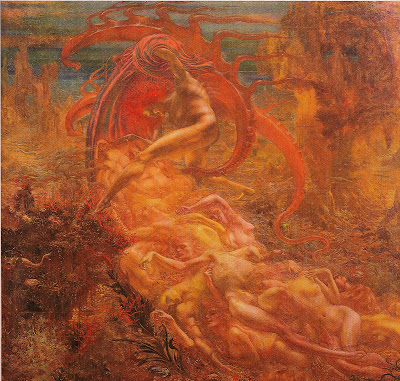
David Larkin is kind of a hero of mine. He is an editor! Much like what I do here, he seeks out beautiful things and puts them all together in one place. Specifically, Larkin is perhaps best known for compiling what you might call Fantasy Art. Through Peacock and Ballantine Books publishers he released a number of excellent little collections in the seventies. Dulac, Rackham, Kay Nielsen and the like have all been handled lovingly by him as well as the Pre-Raphaelites and many others. These books are all still found fairly easily (and cheaply!) in used book stores. I had a few of these books early, when I was still very young and soaking up all the pictorial books on Dad's shelves like a sponge. One of the best was the concisely titled Fantastic Art. The cover art is by Acrimboldo. I have failed to find a respectful documentation of this collection on the net so far so I decided I'd step up to the plate. The book features selections from all the well known greats (Bosch, Goya, Dali, Ernst, Rousseau, Redon, etc.) as well as the legendary Fairy Feller's Master Stroke. But it's the lesser known works that really stand out! Some of these strange, gorgeous, intense images are criminally ignored but not for lack of effort on Larkin's part. Here is his introduction to the book:
"What is fantasy? You might as well try to define truth, or, failing that, have a go at reality. Fantasy is the beautiful, the sublime, the fragile; it is the grotesque and the horrible, it is that which encompasses the real and overtakes it, it is supra-real. It is some strange formulation of an equally bizarre inner statement, which when externalized, comes to mean something quite uniquely important to all men. Fantasy is, well, art.
Throughout the shadowy eons of man's existence there have been some men more committed to the communication of the inexplicable. They have been the philosophers, the scientists and, always, the artists. Some opted for words, some chose music, and happily for the rest of us, a battery of geniuses attempted to convey just what it is they felt-visually. And so we have not merely art, but fantasy in art, mirrors upon mirrors.
This book is not meant to be any sort of definitive, absolute statement on fantasy-that is impossible anyway. Rather, it is intended as a delicious sampling of these 'visionary mavericks', from the wretched little demons of Bosch through the erotically cynical works of a contemporary graphic artist. The similarities, the absurdities, the wonder-that is all the be seen by the individual."
Below are about a third of the images in the book that I have, in my own fashion, selected to display here. As always, click the images to enlarge.

Carved Wood Cupboard - After Lorenz Stoer
(unfortunately this one has a little rip in it in my copy, but damn, thats all wood!)
The back of the book features this quote from the above artist, Thomas Häfner:
"...I find nothing fantastic in so-called fantastic art, it is an aspect of reality in search of sanity beyond normal bounds. I believe that fantastic art is related to the protective dream, that it prolongs the healing dream and finds symbols that change dread into wonder, strangeness and beauty.
As in all figurative art, fantastic art must of course be judged not only by its intentions but by the quality of the execution, and by standards that have been almost totally lost in the turbulence of changing fashions, movements and politics of the art market. This has led to a noticeable helplessness among the critics, who seem to ignore a growing tendency toward the fantastic in the hope that it will fade away and die. I do not believe it will."












Thanks for posting! Found some new painters here.
ReplyDeleteI'm gonna buy this book so hard.
ReplyDelete